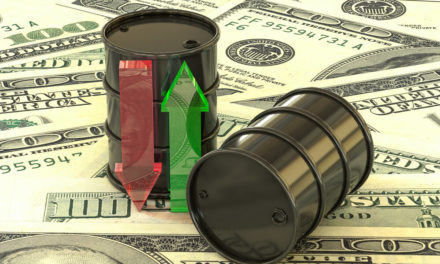As of Tuesday’s market close, oil prices posted their fifth straight day of gains — the longest winning streak since July.
And it came after oil prices plummeted more than a week ago, sending the U.S. stock market into a downward spiral along with them.
West Texas Intermediate crude, the U.S. benchmark for oil prices, gained 20.4% to $24.56 a barrel. It closed above $20 a barrel on Monday — the first time since April.
But one thing to keep in mind, the 52-week high for West Texas Intermediate is more than $65 per barrel, set on Jan. 8.
Brent crude, the international benchmark, moved nearly 14% higher Tuesday to $30.97 per barrel, posting its fifth-straight gaining session.
President Donald Trump also tweeted about oil prices moving upward as a possible sign that the American economy is ready to rev up again.
Oil prices moving up nicely as demand begins again!
— Donald J. Trump (@realDonaldTrump) May 5, 2020
Why Oil Prices Are Moving
Banyan Hill Publishing’s Matt Badiali said there are several factors as to why the price of oil initially dropped in April.
“Oil prices are responding to a couple of things,” Badiali, a geologist and Editor of Real Wealth Strategist, said. “Remember, most folks were focused on futures – not the actual oil price. That’s what went negative. WTI fell hard from fear.”
But then, as Badiali said they would, oil prices began to recover.
“This ‘recovery’ is due to three main forces — initial panic selling, falling oil production and recovering oil demand,” Badiali said.
According to the U.S. Energy Information Association data, production of West Texas Intermediate crude oil has fallen off a cliff.
From a high of around 13 million barrels per day from January 2020 to March 2020, production fell to 12.1 million barrels as of April 24. Oil giants like Exxon Mobil Corp. (NYSE: XOM), Chevron Corp. (NYSE: CVX) and ConocoPhillips (NYSE: COP) have all slashed production levels.
“That data lags by about two weeks, and U.S. oil production is well down from even that level right now,” Badiali said. “It’s down so much that the Texas Rail Road Commission backed off mandatory cuts.”
The Immediate Future of Oil Prices
While the jump in oil has been good news to oil producers like Exxon, Chevron and Conoco, Badiali said prices won’t spike much higher than they are now.
What’s driving the price increase is that many U.S. states are starting to ease their coronavirus-related lockdown measures in hopes of opening the economy.
“So local demand will increase. Slowly, but it will come back,” Badiali said.
But there’s still an underlying problem in the oil market: supply.
U.S. and global production cuts are helping with the fact that there is a glut in the oil supply around the world.
That suggests that while oil prices may continue to climb, they will likely be capped until the supply starts to run out.
“I doubt we’ll see spikes above $40 per barrel until we use it all up,” Badiali said. “Any move in higher prices will be met with a wave of supply from tankers.”
As an investor, consider the road to recovery in the oil market will be long and uncertain, even with producers pushing back operations.
Oil prices will recover, but certainly not in the immediate future.





